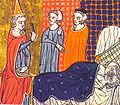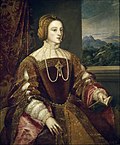This article needs additional citations for verification .(March 2010) |

This is a list of consorts of the monarchs of the Kingdom of Aragon . Blanche II of Navarre and Philip I of Castile died before their spouses inherited the crown.
This article needs additional citations for verification .(March 2010) |

This is a list of consorts of the monarchs of the Kingdom of Aragon . Blanche II of Navarre and Philip I of Castile died before their spouses inherited the crown.
| Picture | Name | Father | Birth | Marriage | Became consort | Ceased to be consort | Death | Spouse |
|---|---|---|---|---|---|---|---|---|
| ? Iñiguez of Pamplona | Íñigo Arista of Pamplona (Íñiguez) | - | 820 | - | - | García Galíndez | ||
| Oneca Garcés of Pamplona | García Íñiguez of Pamplona (Íñiguez) | - | - | - | - | - | Aznar Galíndez II | |
| Acibella Garcés of Gascony | García II Sánchez of Gascony (Gascony) | - | - | - | - | Galindo Aznárez II | ||
| Sancha Garcés of Pamplona | García Jiménez of Pamplona (Jiménez) | - | after 905 | - | - | |||
| Picture | Name | Father | Birth | Marriage | Became consort | Ceased to be consort | Death | Spouse |
|---|---|---|---|---|---|---|---|---|
 | Ermesinda of Bigorre | Bernard-Roger, Count of Bigorre (Foix) | - | 22 August 1036 | 1 December 1049 | Ramiro I | ||
| Agnes | perhaps William VI or William VII, Duke of Aquitaine (Ramnulfids) | - | 1054 | 8 May 1063 husband's death | - | |||
| Isabella of Urgell | Ermengol III, Count of Urgell (Barcelona) | - | 1065 | 1071 separated on grounds of consanguinity | 1071, before 20 December | Sancho I | ||
| Felicia of Roucy [1] | Hilduin IV, Count of Roucy (Montdidier) | - | 1076, or before | 4 June 1094 husband's death | 3 May 1123 | |||
| Agnes of Aquitaine [1] | William VIII, Duke of Aquitaine (Ramnulfids) | - | January 1086 | 4 June 1094 husband's accession | 6 June 1097 | Peter I | ||
| Bertha [1] | of Italian origins | - | 16 August 1097 | 28 September 1104 husband's death | before 1111 | |||
 | Urraca of León and Castile [1] | Alfonso VI of León and Castile (Jiménez) | April 1079 | October 1109 | 1115 marriage annulled | 8 March 1126 | Alfonso I | |
 | Agnes of Aquitaine | William IX, Duke of Aquitaine (Ramnulfids) | late 1103 | 13 November 1135 | 13 November 1137 husband abdication | 8 March 1160, or before | Ramiro II | |
 | Sancha of Castile [2] [3] [4] [5] [6] | Alfonso VII of Castile (Anscarids) | 21 September 1154/5 | 18 January 1174 | 25 April 1196 husband's death | 9 November 1208 | Alfonso II | |
 | Marie of Montpellier [2] [3] [4] [5] [7] | William VIII of Montpellier (Guilhem) | 1182 | 15 June 1204 | 21 January/18 April 1213 | Peter II | ||
 | Eleanor of Castile [2] [3] [4] [5] [7] | Alfonso VIII of Castile (Anscarids) | 1202 | 6 February 1221 | April 1229 marriage annulled | 1244 | James I | |
 | Violant of Hungary [2] [3] [4] [5] [7] [8] [6] [9] [10] | Andrew II of Hungary (Árpád) | 1215/6 | 8 September 1235 | 12 October 1251 | |||
| Picture | Coat of Arms | Name | Father | Birth | Marriage | Became consort | Ceased to be consort | Death | Spouse |
|---|---|---|---|---|---|---|---|---|---|
 |  | Eleanor of Alburquerque [2] [4] [5] [8] [6] [11] [9] [10] [12] | Sancho Alfonso, 1st Count of Alburquerque (Trastamara) | 1374 | 1393/4 | 28 June 1412 husband's accession | 2 April 1416 husband's death | 16 December 1435 | Ferdinand I |
 |  | Maria of Castile [2] [4] [5] [8] [11] [13] [6] [9] [10] [12] | Henry III of Castile (Trastamara) | 1 September 1401 | 12 June 1415 | 2 April 1416 husband's accession | 4 October 1458 | Alfonso V | |
 |  | Juana Enríquez [2] [4] [5] [8] [1] [6] [9] [10] [12] | Fadrique Enríquez, Count of Melba and Rueda (Enríquez) | 1425 | 1 April 1444 | 4 October 1458 husband's accession | 13 February 1468 | John II | |
 |  | Isabella I of Castile [2] [4] [5] [8] [6] [11] [9] [10] [12] [13] [14] | John II of Castile (Trastámara) | 22 April 1451 | 19 October 1469 | 20 January 1479 husband's accession | 26 November 1504 | Ferdinand II | |
 |  | Germaine of Foix [2] [4] [5] [8] [6] [11] [9] [10] [12] [13] [14] | John of Foix, Viscount of Narbonne (Foix-Grailly) | 1488 | 19 October 1505 | 23 January 1516 husband's death | 18 October 1538 | ||
During the war against John II, there were three who claimed his throne, though this never included the Kingdom of Valencia. One of the three was Peter V of Aragon who remained a bachelor. The others, Henry IV of Castile and René of Anjou, had wives during their "reigns" as pretenders. The wife of Henry IV was Joan of Portugal , a Portuguese infanta daughter of King Edward of Portugal and his wife Eleanor of Aragon. The first wife of Rene died prior to 1462; his second wife was Jeanne de Laval , a French noblewoman and daughter Guy XIV de Laval, Count of Laval and Isabella of Brittany.
| Picture | Coat of Arms | Name | Father | Birth | Marriage | Became consort | Ceased to be consort | Death | Spouse |
|---|---|---|---|---|---|---|---|---|---|
 |  | Isabella of Portugal [2] [4] [5] [8] [6] [9] [10] [13] [11] [12] [14] [15] | Manuel I of Portugal (Aviz) | 24 October 1503 | 11 March 1526 | 1 May 1539 | Charles I | ||
In 1556, the union of the Spanish kingdoms is generally called Spain and Mary I of England (second wife of Philip II) is the first Queen of Spain. Philip II was son of Charles I and Isabella of Portugal.
| Picture | Coat of Arms | Name | Father | Birth | Marriage | Became consort | Ceased to be consort | Death | Spouse |
|---|---|---|---|---|---|---|---|---|---|
 |  | Ramon Berenguer IV | Ramon Berenguer III (Barcelona) | c. 1114 | August 1150 | 6 August 1162 | Petronilla | ||